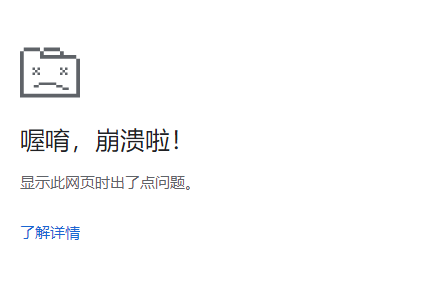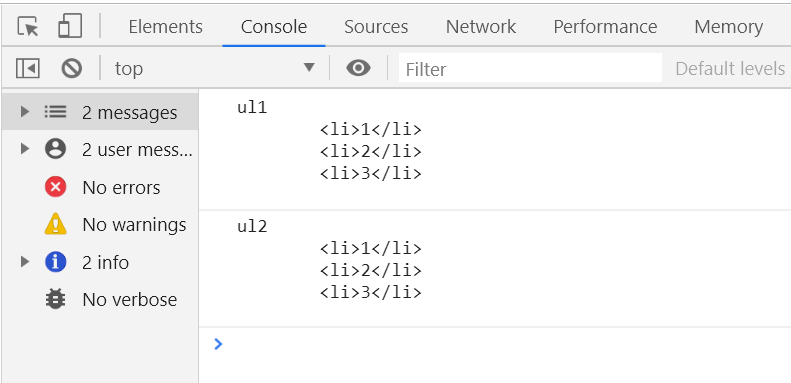操作节点的方法
appendChild()
insertBefore()
replaceChild()
cloneNode()
normalize()
splitText()
sppendChild() 追加子元素
.firstElementChild() 第一个子元素节点
返回值是被操作的那个子节点
<!DOCTYPE html> <html lang="en"> <head> <meta charset="UTF-8"> <title>Document</title> <style> body{ width:100%; height:100%; } </style> <script src="DomReady.js"></script> <script> myReady(function(){ var ul=document.getElementById("myul"); var txt=document.createTextNode("4"); var li=document.createElement("li"); li.appendChild(txt); var myli=ul.appendChild(li); console.log(myli);//返回值是被操作的那个子节点 // 获取到的第一个子元素被移动到了最后 var firstLi=ul.firstElementChild; ul.appendChild(firstLi); }); </script> </head> <body> <ul id="myul"> <li>1</li> <li>2</li> <li>3</li> </ul> </body> </html>
.children.item(n) 获取第n+1个子元素节点
.children[n] 获取第n+1个子元素节点
父元素.insertBefore(被插入的元素,要插入的位置) 会在指定位置之前插入元素
返回值就是新插入的节点
<!DOCTYPE html> <html lang="en"> <head> <meta charset="UTF-8"> <title>Document</title> <style> body{ width:100%; height:100%; } </style> <script src="DomReady.js"></script> <script> myReady(function(){ var ul=document.getElementById("myul"); var txt=document.createTextNode("4"); var li=document.createElement("li"); li.appendChild(txt); var pos=ul.children[2]; ul.insertBefore(li,pos); var myli=ul.insertBefore(li,pos); console.log(myli);//返回值是被操作的那个子节点 }); </script> </head> <body> <ul id="myul"> <li>1</li> <li>2</li> <li>3</li> </ul> </body> </html>
当第二个参数设置为null时,能够实现与appendChild相同的效果
<!DOCTYPE html> <html lang="en"> <head> <meta charset="UTF-8"> <title>Document</title> <style> body{ width:100%; height:100%; } </style> <script src="DomReady.js"></script> <script> myReady(function(){ var ul=document.getElementById("myul"); var txt=document.createTextNode("4"); var li=document.createElement("li"); li.appendChild(txt); ul.insertBefore(li,null); }); </script> </head> <body> <ul id="myul"> <li>1</li> <li>2</li> <li>3</li> </ul> </body> </html>
replaceChild(要插入的节点,被替换掉的节点)
返回值是被替换的节点
<!DOCTYPE html> <html lang="en"> <head> <meta charset="UTF-8"> <title>Document</title> <style> body{ width:100%; height:100%; } </style> <script src="DomReady.js"></script> <script> myReady(function(){ var ul=document.getElementById("myul"); var txt=document.createTextNode("4"); var li=document.createElement("li"); li.appendChild(txt); //ul.replaceChild(li,ul.lastElementChild); var oldLi=ul.lastElementChild; var returnNode=ul.replaceChild(li,oldLi); console.log(returnNode); }); </script> </head> <body> <ul id="myul"> <li>1</li> <li>2</li> <li>3</li> </ul> </body> </html>

不过我发现在控制台尝试想要选中被返回的节点,页面就崩溃了

.cloneNode() 浅拷贝
.cloneNode(true) 深拷贝,会把子元素也拷贝
<!DOCTYPE html> <html lang="en"> <head> <meta charset="UTF-8"> <title>Document</title> <style> body{ width:100%; height:100%; } </style> <script src="DomReady.js"></script> <script> myReady(function(){ var ul=document.getElementById("myul"); var newNode=ul.cloneNode(); console.log(newNode); var newNode2=ul.cloneNode(true); console.log(newNode2); document.body.appendChild(newNode2); }); </script> </head> <body> <ul id="myul"> <li>1</li> <li>2</li> <li>3</li> </ul> </body> </html>

normalize()
normalize() 方法移除空的文本节点,并连接相邻的文本节点
<!DOCTYPE html> <html lang="en"> <head> <meta charset="UTF-8"> <title>Document</title> <style> body{ width:100%; height:100%; } </style> <script src="DomReady.js"></script> <script> myReady(function(){ var div=document.createElement("div"); var txt1=document.createTextNode("hello~"); var txt2=document.createTextNode("cyy~"); div.appendChild(txt1); div.appendChild(txt2); document.body.appendChild(div); console.log(div.childNodes.length);//2 <div>"hello~" "cyy~"</div> div.normalize(); console.log(div.childNodes.length);//1 <div>hello~cyy~</div> }); </script> </head> <body> </body> </html>
splitText(n) 把一个文本节点分割为两个,从位置n开始
并且返回新的文本节点
splitText()方法将在指定的 offset 处把 Text 节点分割成两个节点。原始的 Text 节点将被修改,使它包含 offset 指定的位置之前的文本内容(但不包括文本内容)。新的 Text 节点将被创建,用于存放从 offset 位置(包括该位置上的字符)到原字符结尾的所有字符。新的 Text 节点是该方法的返回值。
<!DOCTYPE html> <html lang="en"> <head> <meta charset="UTF-8"> <title>Document</title> <style> body{ width:100%; height:100%; } </style> <script src="DomReady.js"></script> <script> myReady(function(){ var div=document.createElement("div"); var txt=document.createTextNode("hello~cyy~"); div.appendChild(txt); document.body.appendChild(div); console.log(div.childNodes.length);//1 "hello~cyy~" //div.childNodes[0].splitText(5); //console.log(div.childNodes.length);//2 "hello" "~cyy~" var newNode=div.childNodes[0].splitText(5); console.log(newNode);//"~cyy~" }); </script> </head> <body> </body> </html>
removeChild()
返回被删除的子节点
必须传入参数
<!DOCTYPE html> <html lang="en"> <head> <meta charset="UTF-8"> <title>Document</title> <style> body{ width:100%; height:100%; } </style> <script src="DomReady.js"></script> <script> myReady(function(){ var ul=document.getElementById("ul"); ul.removeChild(ul.children[1]); }); </script> </head> <body> <ul id="ul"> <li>1</li> <li>2</li> <li>3</li> </ul> </body> </html>
removeNode()
是IE的私有实现
删除目标节点。默认参数是false,仅删除目标节点
当参数为true,则会把目标节点的子节点也删除
<!DOCTYPE html> <html lang="en"> <head> <meta charset="UTF-8"> <title>Document</title> <style> body{ width:100%; height:100%; } </style> <script src="DomReady.js"></script> <script> myReady(function(){ // var ul=document.getElementById("ul"); // var removedNode=ul.removeNode(); // console.log(removedNode.outerHTML);//<ul id="ul"></ul> var ul=document.getElementById("ul"); var removedNode=ul.removeNode(true); console.log(removedNode.outerHTML); // <ul id="ul"> // <li>1</li> // <li>2</li> // <li>3</li> // </ul> }); </script> </head> <body> <ul id="ul"> <li>1</li> <li>2</li> <li>3</li> </ul> </body> </html>
removeChild() 和innerHTML的区别
第一组对比
结论:使用removeChild()删除子节点,在IE8以下会有残留,久而久之占用内存
使用innerHTML删除子节点,没有残留
<!DOCTYPE html> <html lang="en"> <head> <meta charset="UTF-8"> <title>Document</title> <style> body{ width:100%; height:100%; } </style> <script src="DomReady.js"></script> <script> myReady(function(){ var div=document.createElement("div"); console.log(div.parentNode);//null 还没有装载到dom树上 // document.body.removeChild(document.body.appendChild(div)); // console.log(div.parentNode);//IE8以下存在文档碎片,其他浏览器为null document.body.innerHTML=""; console.log(div.parentNode);//null }); </script> </head> <body> </body> </html>
第二组对比
<!DOCTYPE html> <html lang="en"> <head> <meta charset="UTF-8"> <title>Document</title> <style> body{ width:100%; height:100%; } </style> <script src="DomReady.js"></script> <script> myReady(function(){ var ul1=document.getElementById("ul1"); ul1.parentNode.removeChild(ul1); console.log(ul1.id + ul1.innerHTML); var ul2=document.getElementById("ul2"); ul2.parentNode.innerHTML=""; console.log(ul2.id + ul2.innerHTML); }); </script> </head> <body> <ul id="ul1"> <li>1</li> <li>2</li> <li>3</li> </ul> <ul id="ul2"> <li>1</li> <li>2</li> <li>3</li> </ul> </body> </html>
普通浏览器结果:

IE8以下浏览器结果:

此时使用innerHTML删除的元素,无法再获取到完整的数据
结论:
在IE8以下,removeChild相当于掰断树枝,innerHTML清空相当于连根拔起
在其他浏览器中,removeChild和innerHTML都相当于掰断树枝,可以再次使用
deleteContents()
textContent